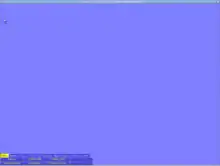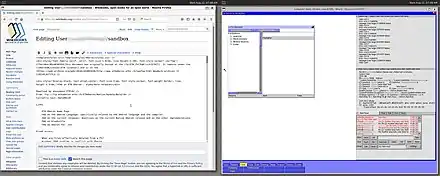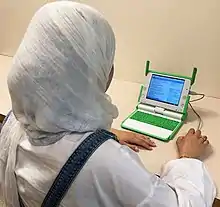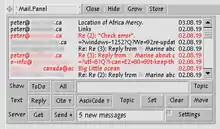A2 has been installed and used on bare PCs. More commonly it is installed as a subsystem on a Unix-like system or on MS Windows.
Installing and Running UnixAOS
The original instructions[1] for installing UnixAOS are in http://www.informatik.uni-bremen.de/~fld/UnixAos/Readme.txt. Installation files are available from http://www.informatik.uni-bremen.de/~fld/UnixAos/.

The shell script installer assumes existence of a sys group in the host. For systems lacking this group, the script is easily adapted. For example, sys can be changed to bin.
chgrp -R sys ${aosdir}
vs.
chgrp -R bin ${aosdir}
In UnixAOS the ext2 filesystem can be used on a removable flash store.
The aos start script, installed by install.UnixAos, by default to /usr/bin/aos, adjusts the operating system environment before starting aos.{solaris,linux,darwin}. As noted in Readme.txt, UnixAos can be started with these two commands.[2]
cd <myWorkingDirectory> aos
<myWorkingDirectory> must be replaced with a specific destination of course.
User and Machine Specific Configuration of UnixAOS
UnixAos is configured by Configuration.XML. The Oberon subsystem is configured by Oberon.Text; refer to the ETH Oberon page and the original betadocu page.

If the working directory is on a removable store, the myaos script allows the storage device to be used in multiple machines with differing configurations. When the store is not already mounted, e2fsck is applied as a precaution.[3] In case the filesystem has been corrupted, e2fsck will usually complete repairs. A reasonable location for the myaos script is the home directory of the user. For each host, create in the working directory files Configuration.<host>.XML. To use the Oberon subsystem, create Oberon.<host>.Text. This can be done by copying the installed files and editing the copies. For example, a host named blunder requires Configuration.blunder.XML for A2 and Oberon.blunder.Text for the Oberon subsystem. The XML file contains ASCII text and can be edited with mousepad or gedit or with PET in A2. The installed Oberon.Text contains some binary information.[4] In S3 it would usually be edited with Edit or ET. Nevertheless plain text will also work. After storing Oberon.Text with ET.StoreChar, it can be edited with Mousepad or Gedit in Linux, with Notepad in MS Windows and with Atom in MacOS. This can resolve the difficulty of a file name, Oberon.<Host>.Text, exceeding the 32 character limit of the Oberon system. myaos copies Configuration.blunder.XML to Configuration.XML and Oberon.blunder.Text to Oberon.Text before starting UnixAos.
The A2 Repository
The contemporary source texts of A2 are maintained in Apache Subversion (often abbreviated SVN) along with executables for several platforms. While older methods to install A2 are available, this method, based on the SVN repository, provides the latest version and allows ongoing updates. In summary, the method is to establish a local copy of the repository and then to update when convenient. The repository is checked out from the ETHZ archive and A2 can be built for various platforms including a bare PC. As of 2020 January it contains completely working executables in subdirectories for (at least) Windows (32 and 64 bit versions) and Linux (Intel 32 and 64 bit versions). There is also an ARM subdirectory, as yet receiving minimal attention and feedback from users. The working copy of the repository will occupy approximately 1 GB.
In a Unix-like System
Install Subversion. As root in Debian for example.
apt-get install subversion
In Redhat.
yum install subversion
At an arbitrary location, <somewhere>, in the user directory make a directory for the working copy of the repository. Eg.
mkdir <somewhere>/a2[5]
Clone the repository into the directory.
cd <somewhere>/a2
svn checkout \
--username infsvn.anonymous \
--password anonymous \
https://svn-dept.inf.ethz.ch/svn/lecturers/a2/trunk .
If svn is interrupted, by a delay causing a timeout for example, this should recover.
cd <somewhere>/a2 svn cleanup . svn update .
This will check whether the local copy is complete.
svn status <somewhere>/a2
Subsequently, the local repository can be updated.
cd <somewhere>/a2
svn update \
--username infsvn.anonymous \
--password anonymous .
See what has changed (including every changed file) since this subversion repository was created. This will produce a very large output.
svn -v log <somewhere>/a2
For additional details refer to the svn manual.
Older instructions, at http://www.ocp.inf.ethz.ch/wiki/Documentation/Installation until November of 2019, remain available from the Wayback Machine. Those pages are not relevant to the SVN archive but contain extensive information about A2 itself.
In Windows
SVN is not distributed with Windows but third party softwares are available. TortoiseSVN is one possibility. Install an SVN client and proceed as for Unix-like system as described above. SVN commands are executed in Powershell or in the cmd console (instead of "mkdir" use "md"; don't include the Backslash indicating continuity of the svn command), both available in Windows 10. The executable script for Windows is named a2.bat rather than a2.sh. If using PowerShell change "oberon" in a2.bat to "./oberon" or ".\oberon".
Running A2
With an A2 repository in place, according to the preceding section, A2 can be executed.
Identify supported architectures.
<prefix> cd <somewhere>/a2/ <prefix> ls -d * (dir /ad in MS Windows cmd) AosVM LanguageReport Linux32 source UnixAos Win64 ARM license.txt Linux64 tools Win32 WinAos
Execute the appropriate start script. This for a 32 bit machine running MS Windows.
./Win32/a2.bat
For a 64 bit machine running Linux.
./Linux64/a2.sh
User Level Applications
Various documents and applications are available via the menu at the lower left of the A2 display. Note Docu > Program Demos and Demos. A mail client using IMAP is at Apps > MailClient. The Oberon subsystem described in the following section has Mail.Panel supporting POP3 and SMTP.
The Oberon Subsystem in A2

Opening the Oberon Sub-system
An Oberon subsystem can be opened with a command in the Autostart section of Configuration.XML as in this example.
<Section name="Autostart"> ... <Setting name="Start an Oberon" value="Oberon.Start Oberon 1100x704 0 74 ~"/> ... </Section>
The dimensions, 1100x704, can be adjusted for satisfactory proportioning of text in a viewer. If the Oberon window is stretched, by grabbing the lower right corner with the mouse, the proportionality of text to viewer is preserved.
Usage Tips, Keyboard and Mouse
Mouse usage is unusual but efficient. Definitely worth the small effort to learn. A mouse with three buttons or two buttons and a wheel is essential. If a mouse button is pressed unintentionally, press all mouse buttons before releasing any. All mouse buttons together have no effect. The <Esc> key is used to interrupt a task. For example it can interrupt a long running FTP.GetFiles in the Oberon subsystem. <F1> sets the * marker. <F2> clears all marks. Additional details are in the keyboard page.
Telnet
Telnet is an insecure protocol but can allow a host console within the Oberon sub-system.[6] That will allow command line access to the host from Oberon. Install the telnet daemon the host.
apt-get install openbsd-inetd inetutils-telnetd
Configure with this line in /etc/inetd.conf.
telnet stream tcp nowait <user> /usr/sbin/tcpd /usr/sbin/telnetd -E bin/bash
<user> must be replaced with the id of the Oberon user. Restart the inet daemon.
service openbsd-inetd restart
Then try telnet from within a console in the host.
telnet localhost
Then in the Oberon sub-system.
Desktops.OpenDoc telnet://localhost
To be automatically located in the home directory, append this line to ~/.bashrc.
cd ~

The Oberon subsystem in A2 supports POP and POP3 for retrieving e-mail and SMTP for sending it. In UnixA2 (=UnixAos) the subsystem can receive e-mail from a smarthost via Stunnel and send a message via Exim with TLS.[7] TLS is now routine practice; essential to preserve security.
In Oberon.Text (Oberon.<host>.Text if using myaos) make these settings.
NetSystem = {
SMTP = "localhost" {* outgoing exim4 mail server *}
POP = "localhost" {* stunnel to incoming mail server *}
...
POPMode = "POP3" {* POP3 or APOP *}
EMail = "me@my.domain.name" {* your return address *}
...
}
Ports 25 for SMTP and 110 for POP are visible in Oberon.Mail.Mod.
Install stunnel on the host and configure as in this example. The server name and port, exemplified by my.email.server:995, should be adapted to context.
# localhost:/etc/stunnel/stunnel.conf # Example SSL client mode services [pop3] client = yes accept = localhost:110 connect = my.email.server:995
Set the POP authentication using NetSystem.SetUser as in this example.
NetSystem.SetUser pop:myEmailID:myEmailPassword@my.email.server ~
If MyEmailID contains @, a SetUser command containing two @ characters will fail. This command, for example, will fail.
NetSystem.SetUser pop:me@my.domain.name:password@my.email.server ~
The difficulty is avoided by percent-encoding the @ character in the email client ID.
NetSystem.SetUser pop:me%40my.domain.name:password@my.email.server ~
For the percent-encoding to work, add Oberon.RFC3986.Mod and modify or replace Unix.Oberon.NetSystem.Mod to use the encoding. Compile the two modules with a MM click on this command in an A2 window or use the compile button in the PET editor. The compilation must be performed in A2; not in the Oberon subsystem.
Compiler.Compile Oberon.RFC3986.Mod Unix.Oberon.NetSystem.Mod ~
Import of RFC3986 by NetSystem imposes the order of compilation.
Install Exim in the host according to system specific documentation for Debian, Fedora/CentOS and etc. [8] Exim authenticates to a smarthost according to a password file.[9] Details of configuration for a specific mail server can be obscure. For example, STARTTLS or TLS on connect might not be specified. Before attempting to configure Exim, ambiguities are best resolved using Swaks. Replace parameters -au, -ap, -f and -t with appropriate values for user, password and email address.[10]
swaks -tls \ -ao -apt -au me@my.authentication.domain -ap r2d2\$8Ch \ -s my.smarthost.com --port 587 \ -f me@my.email.address -t me@my.email.address
The example password has eight characters; the \ prevents misinterpretation of the $ character. Swaks creates a trivial test message automatically. Parameters of the command can be adjusted until transmission succeeds. Transmission can be confirmed by receipt in Oberon as discussed above. Refer to the excellent manual for all details.
Sources, Tools and Configuration Texts in A2
A tiny sample of the approximately 2000 sources in A2. Access the ETHZ Repository with userid infsvn.anonymous and password anonymous.
A contemporary Firefox browser attempts to infer "Content type" from the name extension. By default Firefox infers wrongly that source file *.Mod contains "Amiga SoundTracker audio" and fails to open it. This difficulty is resolved by adjusting the "Action" Firefox associates with "Content Type". Open hamburger menu > Preferences > General > Applications. For "Amiga SoundTracker audio" choose an editor such as /usr/bin/mousepad or /usr/bin/gedit. Most sources in A2 have been converted to plain ASCII text; some remain as Oberon Text. Gedit will open all of these. Mousepad and several other editors will not open Oberon Text. Content type "plain text document" should also be set to the chosen editor. With these adjustments Firefox should open most of the files in the repository.
In some contexts the user may fail to find a configuration of a browser to open files in the repository. In any case a browser should open the Wikibook copy.
| ETHZ Repository | Wikibook copy[11] | Notes |
|---|---|---|
| BIOS.V24.Mod | BIOS.V24.Mod | |
| BootManager.Asm | BootManager.Asm | BootManager source written in Network Assembler by André Fischer. |
| BootManager.Mod | BootManager.Mod | Module containing one command Split.[12] |
| BootManager.Text | BootManager | Instructional document written by André Fischer. In the repository and in MediaWiki representation. |
| BootManager.Tool | BootManager.Tool | Tool file summarizing the instructional document. |
| Oberon.Configuration.Mod | ||
| Configuration.XML | Configuration.XML | |
| Oberon.Desktops.Mod | ||
| Oberon.Documents.Mod | ||
| Oberon.ET.Mod | ||
| Oberon.Files.Mod | ||
| Oberon.HTML.Mod | Oberon.HTML.Mod | Revisions for conformance to HTML5. |
| HTML.Tool | No "preview" in the ETH Repository. | |
| Oberon.HTMLDocs.Mod | Oberon.HTMLDocs.Mod | InitEntities() expanded to support more characters. |
| Oberon.ISO9660Files.Mod | ||
| Oberon.ISO9660Volumes.Mod | ||
| Oberon.MIME.Mod | Oberon.MIME.Mod | |
| Oberon.Mail.Mod | Oberon.Mail.Mod | Deviation from SMTP corrected. Wrap() added. Names of types revised. Show() revised. Calculation of cont.len corrected. |
| Oberon.MediaWiki.Mod | Not in A2 repository. | |
| Oberon.Objects.Mod | ||
| Oberon.Out.Mod | Oberon.Out.Mod | Allow delay of execution of Append, using a flag variable. |
| Oberon.Out.Mod | Oberon.Out1.Mod | Allow delay of execution of Append, using a procedure variable. |
| Oberon.OutStub.Mod | Not in A2 repository. | |
| Oberon.QuotedPrintable.Mod | Oberon.QuotedPrintable.Mod | Variant from LinuxA2 Gen. 32-bit, rev.9527. |
| Oberon.RFC3986.Mod | Percent encoding and decoding of URL. Not in A2 repository. | |
| Oberon.Sort.Mod | Oberon.Sort.Mod | Better presentation of output. Revisions incomplete. |
| Oberon.Strings.Mod | ||
| Oberon.TFTPTool.Mod | Oberon.TFTPTool.Mod | |
| Oberon.TextDocs.Mod | ||
| Oberon.TextFrames.Mod | Oberon.TextFrames.Mod | LOOPs removed. |
| Oberon.Texts.Mod | ||
| Oberon.V24.Mod | Oberon.V24.Mod | |
| Release.Oberon.Text | Oberon.Text | Usually Oberon.Text is customized to a user. |
| TFTP.Mod | TFTP.Mod | |
| Unix.Oberon.NetSystem.Mod | Unix.Oberon.NetSystem.Mod | Percent encoding added to allow special characters in a userid or password. See RFC3986 above. |
| myaos | Not in A2 repository. |
Footnotes
- ↑ The SVN repository, described subsequently, is a more recent method of installation and release tracking.
- ↑ The command line prefix in a Unix-like system is user configurable and can be configured to the empty string. For simplicity, the prefix is omitted in most of the commands shown here.
- ↑ A filesystem can become corrupted if not unmounted before the system is shut down. The directory can also be damaged by natural degradation of the storage media. If the filesystem is intact, the execution time for e2fsck is negligible.
- ↑ See Oberon Text.
- ↑ In a Unix like system, many variations are available.
cd ~ ; mkdir a2for example. - ↑ The LAN can be secured by a firewall. Shorewall is recommendable.
- ↑ The same functionality of the Mail.Panel is available in ETH Oberon when another local host provides Exim and Stunnel.
- ↑ The primary Exim documentation is also available.
- ↑ In Debian, /etc/exim4/passwd.client associates a password with each (host, user) pair. Multiple host:user:password specifications are acceptable. The file does not determine the destination chosen by exim for sending a message. Refer to the exim4-config_files manual.
- ↑ me@my.authentication.domain is a userid pattern commonly used by ISPs.
- ↑ In some cases the Wikibook copy will differ from the latest file in the ETHZ repository. For an exact comparison, use a file comparator; Diff.Do in Oberon, comm in Linux.
- ↑
BootManager.Split BootManager.Binis executed to divide BootManager.Bin into BootManagerMBR.Bin and BootManagerTail.Bin. For additional details, refer to the instructional document of André Fischer.